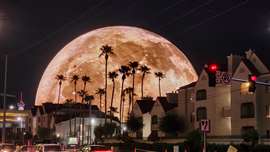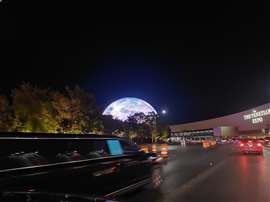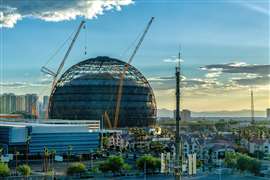What is holding up construction of the next MSG Sphere in London?
01 November 2023
 The Sphere at Las Vegas displaying an image of the Moon on its exosphere screen (Image: Marcus Jones via AdobeStock - stock.adobe.com)
The Sphere at Las Vegas displaying an image of the Moon on its exosphere screen (Image: Marcus Jones via AdobeStock - stock.adobe.com)
Few megaprojects are as eye-catching as the recently completed, $2.3 billion Sphere at the Venetian Resort in Las Vegas, USA.
In fact, the massive structure, which stands at 112 metres high and 157 metres wide, is so technologically advanced that it has the capability to turn itself into a massive, blinking eyeball, as well as any other spherical-shaped object programmers care to conjure up.
That’s because the Sphere has a 54,000 sq m, fully programmable LED exterior screen, as well as an interior 16K display equipped with millions of LEDs. The interior display is reportedly the highest-resolution LED screen on Earth and measures 15,000 sq m. It forms the backdrop to a huge stage that takes up one third of the interior space to host concerts from the likes of U2, who have taken up residency there, for 18,600 audience members.
Particularly impressive at night, the Sphere can be seen for miles. With Formula 1 race cars set to zoom past it later this month in the Las Vegas Grand Prix, it has already become a landmark in the city following its opening at the end of September.
The company behind it, Madison Square Garden Entertainment, has plans to build other such spheres in cities around the world.
One of the first it is targeting is London, in the arguably somewhat less impressive surroundings of former coach park for the London 2012 Olympics, between Stratford Station and the Olympic Park.
The new MSG Sphere in London would have a capacity of 21,500 people, with a similar interior and exterior display. Previous estimates have put the cost of building the London structure at £800m (US$979 million).
 The completed Sphere at the Venetian Resort (Image: Nataliia via AdobeStock - stock.adobe.com)
The completed Sphere at the Venetian Resort (Image: Nataliia via AdobeStock - stock.adobe.com)
However it is not clear how accurate that figure is. Aside from the effects of inflation over the past couple of years, the footprint of the London site will be smaller, meaning that the design for the Sphere there would be different. Also designed by Populous, it would be around 90 metres high and 120 metres wide and sit on a podium that would see back office areas sit beneath it, in contrast to the Vegas site.
The fact that the design and construction has already be proven in Las Vegas, therefore making construction in the UK a case of repeating techniques rather than innovating, could also have a positive effect on the overall cost.
Nonetheless, the proposed structure would be more than big enough to make its presence known on the London skyline. And that is at the root of uncertainty around whether it will actually get built.
More than 1,000 local residents have formally objected to a planning application for the scheme, while 2,000 signed a petition calling for the project to be scrapped.
They have cited concerns including local residents having their sleep disrupted by lights and moving imagery, likely to include adverts, as well as the effect it could have on wildlife.
MSG has previously attempted to allay fears by promising that the London Sphere would operate at a lower brightness and at different times of the day to the Sphere in Las Vegas.
The London Legacy Development Corporation (LLDC) gave approval to the plans for the new Sphere last year. But the project now sits in a ‘stage two review’. That means it will need to be approved by both Mayor of London Sadiq Khan and the UK government.
Since the LLDC is a mayoral development corporation formed at the end of the London Olympics in 2012, Khan has only two options - either to reject the project directly, which is seen as unlikely, or to indicate that he is content for it to go forward.
At that point, it would go to the UK government’s Department for Levelling Up, Housing and Communities, giving secretary of state Michael Gove the final say. Gove could decide to allow the project to move forward with little further scrutiny, or he could “call in” the project for a further lengthy review.
In the meantime, Gove has issued a section 31 holding directive that prevents the LLDC and Khan from moving the project forward.
Since February this year, there has been no news on what the government intends to do, nor where the plans go from here.
In the meantime, the Sphere’s developers have emphasised estimates that the Sphere could provide a £2.5 billion boost to the London economy, as well as creating 1,200 jobs.
And MSG is also looking at South Korea as another potential location for the construction of a Sphere. Ultimately, the company plans to build several around the world. Whether the next one comes in London, or elsewhere, depends on how quickly the planning process in the UK capital takes to resolve.
The construction of the Las Vegas Sphere
 Construction of the Las Vegas Sphere (Image: atosan via AdobeStock - stock.adobe.com)
Construction of the Las Vegas Sphere (Image: atosan via AdobeStock - stock.adobe.com)
The Sphere at the Venetian Resort is the largest spherical structure on the planet and its construction was no small undertaking.
Work on the building, designed by Populous, started in 2019 with the excavation of nearly 84,000 cubic metres of dirt.
The way in which it was built gives an insight into what could follow for London if plans are approved. Construction works required the assistance of the world’s fourth-largest crane, a Demag CC-8800 crawler crane that was shipped over from Belgium and reassembled on site to lift some of the heavy structural steel sections required.
The heaviest lift came in October 2020 with installation of two 240-tonne steel girders. A few months later came a 170-tonne steel compression ring.
The Sphere’s roof required a total of 3,000 tonnes of steel made up of 32 trusses. Once the steel frame was complete, a total of 4,600 cubic metres of concrete was pumped onto the roof to form a 25cm-thick layer.
Work on the external exosphere started in 2022, built by connecting triangular trusses around the dome. Meanwhile a massive steel interior frame was designed to support the internal LED screens.
The last stage of the project involved kitting out the interior and exterior LED screens. The screen on the exosphere is made up of 1.2 million pucks, each containing 48 individual LED lights that can display 256 million colours.
While Aecom started the project as general contractor, it was removed from that role in 2020. Instead, MSG took over the management of the project, with Aecom to supporting it with a services agreement.
Costs on the project ballooned from an initial estimate of $1.2 billion to a final estimated figure of around $2.3 billion, making it the most expensive entertainment venue in Las Vegas history.
STAY CONNECTED



Receive the information you need when you need it through our world-leading magazines, newsletters and daily briefings.
CONNECT WITH THE TEAM








